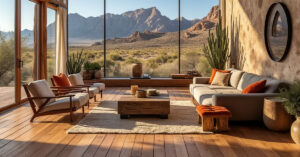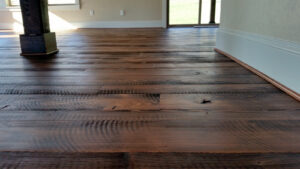What is the best hardwood flooring for dry climates?
Posted: October 28, 2024Author – Ryan Palma Owner/CEO Sustainable Lumber Co.
Click on these links to view our extensive line of sustainable hardwood flooring, or to contact us for a pricing quote.
What is the best hardwood flooring for dry climates?
 Dry climates present a unique challenge for hardwood flooring, primarily with regard to moisture content and potential for wood shrinkage or expansion. Wood naturally reacts to its environment. In dry climates, the lower humidity levels can cause wood to lose moisture, leading to gaps between planks or even wood splitting. Therefor, choosing the right type and species of wood is crucial for maintaining the integrity and aesthetics of the flooring. There are 2 types of hardwood flooring, solid and engineered.
Dry climates present a unique challenge for hardwood flooring, primarily with regard to moisture content and potential for wood shrinkage or expansion. Wood naturally reacts to its environment. In dry climates, the lower humidity levels can cause wood to lose moisture, leading to gaps between planks or even wood splitting. Therefor, choosing the right type and species of wood is crucial for maintaining the integrity and aesthetics of the flooring. There are 2 types of hardwood flooring, solid and engineered.
Solid Hardwood Flooring
 Solid hardwood flooring is made from a single pieces of wood, usually 3/4″ thick. A solid hardwood floor is very durable as it can be sanded and refinished multiple times throughout its life. Solid hardwood is more susceptible to changes in humidity. It might shrink or expand more noticeably than an engineered floor. However, by selecting a stable wood species such as our Douglas Fir flooring, and ensuring proper acclimatization before installation, solid hardwood can perform well even in dry climates.
Solid hardwood flooring is made from a single pieces of wood, usually 3/4″ thick. A solid hardwood floor is very durable as it can be sanded and refinished multiple times throughout its life. Solid hardwood is more susceptible to changes in humidity. It might shrink or expand more noticeably than an engineered floor. However, by selecting a stable wood species such as our Douglas Fir flooring, and ensuring proper acclimatization before installation, solid hardwood can perform well even in dry climates.
Engineered Hardwood Flooring
An engineered hardwood floor is made from multiple layers of wood with a top veneer (called a wear layer) of the desired hardwood species. The overall thickness of an engineered floor can vary from 1/4″ thick to 3/4″. It is important to choose a thicker engineered floor when installing in dry climates. The wear layer can vary from paper thin to 1/4″. An engineered floor with a very thin wear layer can only be refinished one time, if at all. If you choose an engineered floor with a thick wear layer like a 1/4″, you can refinish as many times as a solid hardwood floor. Engineered floors are known to be more stable versus solid and are a great choice over radiant heating and basements, due to its stability.
 Best Wood Species for Dry Climates
Best Wood Species for Dry Climates
Known for its durability and resistance to wear. White Oak has a moderate to high density, which means it’s less likely to shrink or expand drastically in dry conditions. White Oak features a light to medium brown color with a straight grain, making it versatile for various interior styles. White Oak is commonly available in both solid and engineered flooring. Its cellular structure makes it a good choice for dry environments.
One of the hardest domestic hardwoods, hickory has a high density which helps it resist wear and tear. However, its high oil content might lead to a more pronounced reaction to humidity changes if not properly sealed. Hickory color ranges from white to medium reddish-brown with frequent bold grain patterns. Hickory is better suited as engineered flooring in dry climates due to its stability versus the potential expansion and contraction in solid form.

Conclusion
For dry climates, engineered hardwood generally offers better stability due to its construction, making it less prone to the drastic changes that can affects wood’s integrity.
Quick Comparison:
White Oak – Stands out for its balance between beauty, durability, and stability, making it an excellent choice in both solid and engineered forms.
Hickory – While incredibly hard and beautiful, might be better installed as engineered wood in very dry environments to prevent potential issues from its natural oils
Douglas Fir – Provides a good middle ground, offering both aesthetic appeal and exceptional stability in dry conditions.
When choosing a hardwood floor in a dry climate, consider not just the type of wood, but also the construction of the flooring. Proper installation, acclimatization, and maintenance are also key to ensuring your hardwood floors thrive in a dry environment. Always consult with a local professional for the best fit for your specific climate and home conditions.
Contact Us:
Our knowledgeable and educated staff is here to answer any additional questions you may have. Please call us today for a free quote: Ph# 406.642.7120 or click here to submit an inquiry online. We look forward to working with you on your next project!


